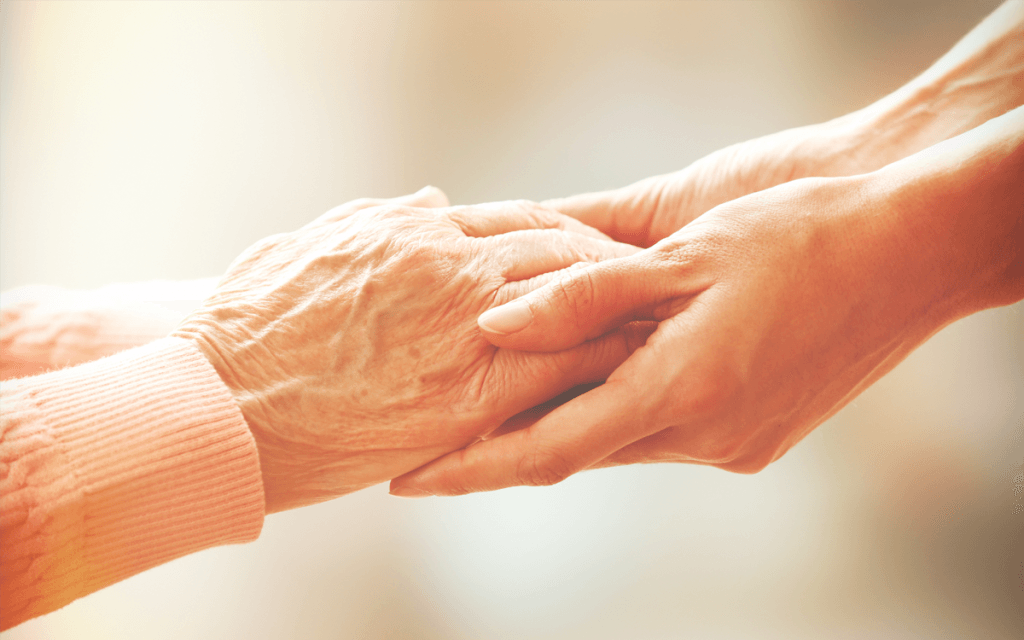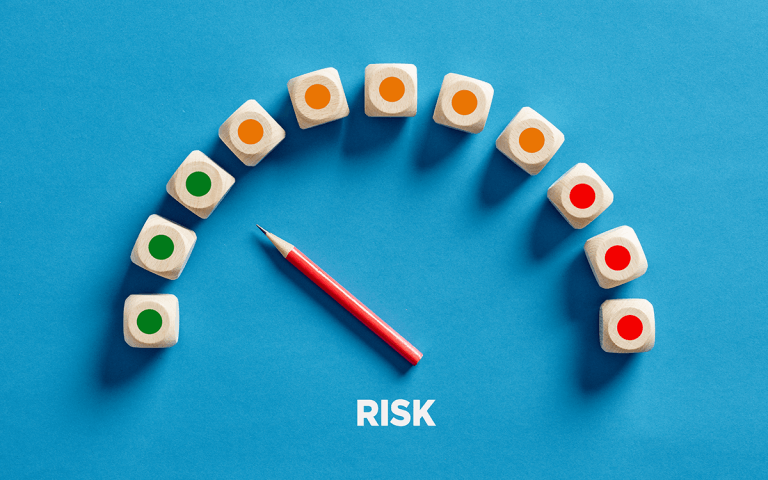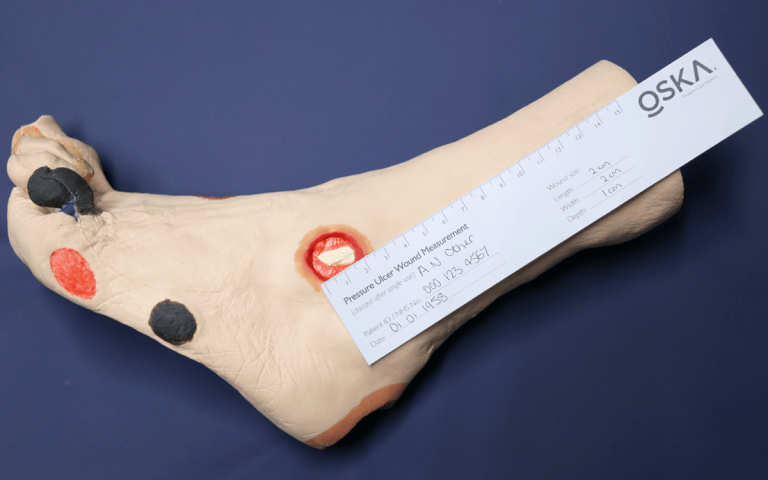Love’s Final Embrace: How OSKA is breaking down barriers
Touch provides a myriad of sensations and feelings, from comfort, support, pain, healing, love, and so much more. In most cases, it also makes our connections with others stronger and is considered a basic need not only for our physical wellbeing, but also that of our mental health.
Human touch is essential through all stages of life; we have always understood that first touch experiences as a baby are fundamental for cognitive and emotional development (Cleare, 2021). However, as we grow older and approach our elder years when we might perhaps receive end-of-life care, we seem to forget just how important touch is in someone’s final moments.

When we experience touch or a warm embrace, we know it feels good. Scientists say the perfect hug should last more than five seconds, and up to 20 seconds, but have you ever wondered why? The scientific benefits of a hug on our bodies include:
- A reduction in the stress hormone cortisol when a person experiences physical touch.
- With cortisol levels decreasing, the feeling of relaxation and calmness is increased.
- Touch calms us by slowing our heartbeat and lowering our blood pressure.
- Human touch also increases our emotional bonds with others through the release of oxytocin.
- There is a strong correlation between the deprivation of touch and corresponding feelings of anxiety and depression.
(McNichols, 2021) (Wooddell, 2023)

Touch is at the very forefront of human connection and when this is taken away from us, we suddenly realise just how fundamental it is. If we step back to a time that seems so alien to us now, the COVID-19 pandemic in 2020 brought so many unexpected challenges connecting with loved ones and cherishing precious moments together. What was once taken for granted, the world found itself starved of human connection. We were forced to adjust to a new normal of online video calls and in time, socially distanced short walks. Despite our ever evolving, digitally connected world, metaphorically we never found ourselves so far apart from one another. Overnight we became acutely aware that the importance of human touch simply cannot be replaced.
Many faced the devastating experience of not being able to say a final goodbye to a loved one face-to-face. Hospitals, hospices and care homes were forced to pull up the drawbridge, forcing family and friends to say a final goodbye through a screen or on a phone, truly depriving everyone of love’s final embrace.

In healthcare, we focus on the advancements of medical science, technological interventions, and cutting-edge treatments to ease suffering and prolong life. But at what cost? As a person nears the end of their life, the most powerful intervention may not come from machines or medication, but from something much simpler, more powerful, and more deeply human: the simple act of touch.
Taking on a more profound significance when we are dying, touch provides emotional support, reduces pain, and fosters a deeper connection when words may no longer be enough. Its importance cannot be underestimated, emphasising its physical, emotional, and sometimes spiritual impact on patients during their final days and hours.
Said to be one of the last senses to fade when death is near, we know patients may lose the ability to communicate verbally due to weakness, sedation, acute pain, or cognitive decline. In these moments, touch becomes a vital form of communication – a silent language, transcending words. A gentle hand giving a soothing back rub can convey love, empathy, care, and being physically present. These non-verbal cues provide a sense of connection and security. Touch also reinforces to the patient they are not alone, fostering a much deeper connection in moments when isolation and fear may feel overwhelming for both parties.
But, despite the relaxation of the physical restrictions of the pandemic, we must ask ourselves why are we still tackling some of the physical barriers of embracing loved ones in their final moments? During this time, it is not uncommon for patients to feel physically isolated and ‘barricaded in’ by the side rails fitted to their bed. Fitted as a safety precaution to help protect against falls and injuries, why should they also act as a physical barrier to their loved ones who simply want to climb in and lie close together?

Dying can feel like a solitary experience, but through compassionate touch, patients are reminded they are cared for and loved, right until the very end. Here at OSKA, the new Embrace Cuddle Bed is breaking down these physical barriers with a patient-first approach.
With quickly extendable sides, the OSKA Embrace Cuddle Bed is big enough for two and is designed to allow loved ones, partners, and children to gently climb in and lie next to patients to be close during their final days and hours together. Dying matters and that is why the features of this incredibly versatile cuddle bed make Embrace a truly standout bed for end of life care, benefitting both the patient and their loved ones.
Balancing the challenge of providing high-quality clinical care whilst also maintaining compassion, dignity and patient comfort, will always exist, especially when so many beds prioritise clinical functionality which often leaves patients and loved ones so physically disconnected from one other. As clinicians and caregivers, we have the ability to ease suffering, relieve pain, and offer connection with the OSKA Embrace Cuddle Bed. Incorporating touch into end-of-life care can transform what might otherwise be a cold, clinical experience into one of deep compassion, humanity and warmth. In those final moments, when words may fail everyone, the simple act of touch speaks volumes. It tells the patient, “you are not alone,” and that in itself, is the ultimate act of love.
Love knows no boundaries. Neither does the OSKA Embrace Cuddle bed.

Please cite as: OSKA Care Ltd. Dec 2024. Love’s Final Embrace: How OSKA is breaking down barriers. Havant, Portsmouth: OSKA Care Ltd.
Read more OSKA blogs & Articles
References
- Cleare, A. (2021). The Role Of Touch In Child Development. [online] Positive Parenting Project. Available at: https://anitacleare.co.uk/the-role-of-touch-in-child-development/#:~:text=One%20of%20the%20first%20tasks [Accessed 30 Aug. 2024].
- Ferrell, B., & Coyle, N. (2010). Textbook of Palliative Nursing (3rd ed.). [Accessed 30 Aug. 2024]
- Kutner, J. S., & Smith, M. C. (2004). Massage therapy versus simple touch to improve pain and mood in patients with advanced cancer: a randomized trial. [Accessed 30 Aug. 2024]
- McNichols, N. (2021). The Vital Importance of Human Touch. [online] Psychology Today. Available at: https://www.psychologytoday.com/us/blog/everyone-on-top/202108/the-vital-importance-of-human-touch#:~:text=Human%20touch%20also%20lowers%20blood [Accessed 30 Aug. 2024].
- Oxytocin and End-of-Life Care: Enhancing Human Connections (2020). [Accessed 30 Aug. 2024]
- Wooddell, B. (2023). The Benefits of Intimacy: How physical touch can improve mental and physical health. [online] Bloom Tampa Bay. Available at: https://www.wfla.com/bloom-tampa-bay/the-benefits-of-intimacy-how-physical-touch-can-improve-mental-and-physical-health/ [Accessed 30 Aug. 2024].




